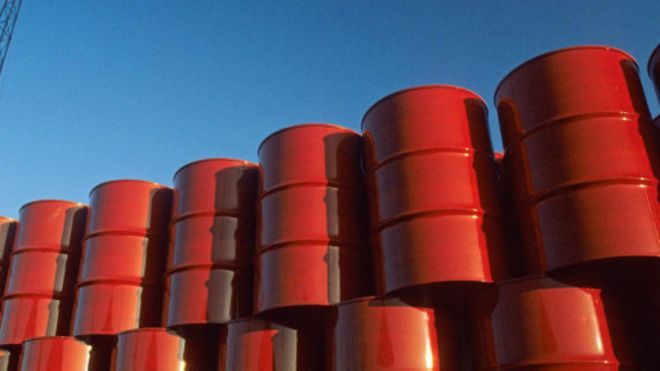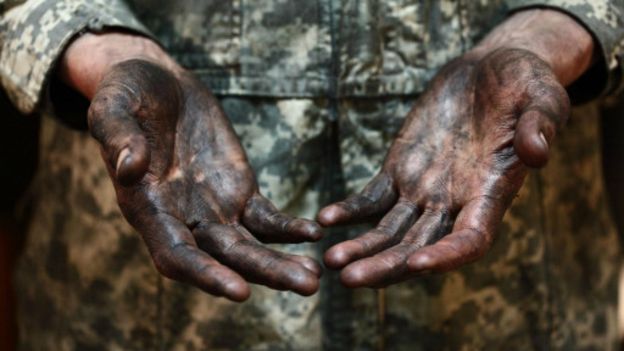美国为何在地下储备7亿桶石油?
BBC克里斯·巴然纽克(2023年9月26日)

美国共储存了7亿桶石油(图片来源:Getty Images)
美国南方漫长的墨西哥湾沿岸海岸线下面埋着许多不为人知的秘密。在外观平淡无奇的4个安全储存点的地下设施内,共储存了将近7亿桶石油。在地下岩层内挖掘的60个岩盐洞穴构成了美国巨大的“战略石油储备”。
这一设施建于40年前,目前,全球各地依然分布着大量巨型石油储存设施。事实上,许多国家已经耗资数十亿美元建造此类石油储存设施,更多国家正在亦步亦趋。那么,这些石油储备资源到底是什么 – 为什么所有人都想把石油埋回到地底下呢?
答案要从1973年能源危机说起。当时,为了抗议美国在赎罪日战争中支持以色列,阿拉伯各石油输出国联手中断了向西方的石油出口。因为整个世界当时都高度依赖于中东石油,因此石油价格陡然飙升。美国加油站开始定量供应汽油,某些地方甚至完全断绝了汽油供应。人们开始担心他们的汽油会被人偷走,有少数人甚至持枪保卫他们的汽车。
石油保卫战
几年过后,美国开始建设战略石油储备,用原油将地下洞穴填满。在未来石油供应遭到严重威胁的情况下,美国将抛出石油储备以平抑石油价格、减轻全球能源市场压力。一家政府网站称,“规模宏大的战略石油储备…使它能够有效应对石油进口中断的冲击,使其成为一个外交政策工具。”这是一个切实可行但是代价高昂的主意。本年度维持战略石油储备所需资金高达2亿美元。
“规模宏大的战略石油储备…使它能够有效应对石油进口中断的冲击,使其成为一个外交政策工具。”
美国能源部的鲍勃·考宾(Bob Corbin)是负责确保该笔资金得到有效使用的官员。“所有储备设施都位于人们称之为‘盐丘’的地质构造里,”他说。“原油无法渗透岩盐,二者不会混合,岩盐也不会崩解,是非常理想的储存场所。”考宾曾在美国海岸警卫队服役22年,他管理下的4个储油设施分布于从路易斯安那州巴吞鲁日(Baton Rouge)到德克萨斯州小镇佛里顿(Freetown)郊区的漫长地带,其中,佛里顿的设施规模最大。他把这些巨型岩盐储油设施称为“山洞”。“这些储油点能给你留下非常难忘的印象”,考宾说。
这些储油设施在地面上基本上看不到任何痕迹,仅能看见少量井口装置和管道。竖井深入数千英尺下的洞穴,能够以高压将水打入地下,然后通过置换作用将石油提取出来。考宾说,对这些设施进行管理是一项独特的挑战。例如,地下盐穴并不完全稳定。有时侧壁或顶板会发生崩塌,从而导致机械设备的损坏。这时需要十分认真仔细地予以替换。和通过天然竖井开采石油的作业类似,工作人员无法亲身进入洞穴,只能远程操作。

国际条约规定,会员国必须保持相当于90天进口量的石油储备。(图片来源:Getty Images)
然而,如果采用特殊设备,也可一探洞穴中的奥秘。“洞穴会定期清空,这时可以拍摄洞穴的声呐影像,”考宾说。“这就提供了洞穴的三维视角。”他还说,有些洞穴有着有趣的形状。例如,一个洞穴看上去很像是一架超大尺寸的飞碟。
过去,美国依赖于战略石油储备以备不时之需。例如,第一次海湾战争期间,中东的石油供应链被切断。再如2005年卡特里娜飓风。在飓风登陆的24小时内,政府就批准了紧急调用应急石油储备的请求。
各国储备情况
除美国外,很多其它国家也在战略石油储备上投入巨资。日本建设了多个储存点,在地上大型储油罐中储存了5亿多桶石油。例如,志布志市(Shibushi)就有近海储油设施。2011年日本发生强烈地震和海啸后,由于担忧未来可能出现影响石油供应的危机,有关人士开始呼吁扩大该国石油储备的规模。
国际能源组织(IEA)负责管理各国石油储备的调拨。马丁·杨(Martin Young)为该组织紧急政策事务部主管:“一国加入国际能源组织后,就要承担很多义务,”他说。“其中一个重要义务就是保持相当于90天进口量的储备。”
但是,并非所有国家都拥有可地下储存石油的盐丘,也并非所有国家都拥有大型专用储油设施用于战略石油储备用途。英国就是一个例子。“英国要求各企业在保持业务运营的同时,有义务利用现有设施储存多于业务正常需要的石油,”杨解释说。这样政府就可以在必要时随时即刻征用企业的石油储备。
印度和中国尽管并非国际能源组织会员国,但是近年来也开始投入资金建设自己的战略石油储备。中国在这方面的目标尤其宏大。中国希望在其广袤国土上建设多种类型的国有和私营储存设施,最终使其石油储备量达到与美国相当的水平。中国境内没有岩盐洞穴,因此只能转而采用造价更为高昂的地上储油罐,这些储油罐在Google Earth和卫星地图上很容易辨识 ,只需寻找排列整齐的大号白色圆点即可。其中,位于浙江镇海的战略石油储备设施目前总储油能力达3300万桶。“它的规模非常大,”杨说。他曾在几年前访问过该储油设施。“当地建设了大量储油罐,旁边就是好几家炼油厂。”
“要想成为一个现代超级大国,就必须拥有自己的石油储备。”
里昂证券的油气行业分析师Narongpand Lisapahanya说,在建设战略石油储备上投入巨资是中国希望成为全球超级大国计划的一个重要组成部分。“要想成为超级大国,就必须拥有自己的石油储备,”他笑着说。“这样你就能成为国际条约规则的一部分。如果发生了能源危机,另外一个大国请求开放储备,中国就能参与进去。”
当前,如果某国没有建立自己的战略石油储备,就无法成为真正的现代超级大国。尽管战略石油储备规模的扩大在全球受到广泛欢迎,但仍有人担心某些非国际能源组织会员国可能通过在适当时机抛售其石油储备,进而操纵全球石油价格。当然,正如美国能源部的Carmine Difiglio所言,建立战略石油储备的最初目的就是为了缓解油价上涨带来的压力:“保护美国不受国内石油产品价格暴涨的危害正是当初在1975年建立战略石油储备的目的,这个初衷今天依旧没变,”他说。
如果没有建立自己的战略石油储备,这个国家就无法成为真正的现代超级大国。尽管石油储备规模的扩大在全球受到广泛欢迎,但仍有人担心某些非国际能源组织会员国可能通过在适当时机抛售其石油储备,进而操纵全球石油价格。当然,正如美国能源部的卡明·迪菲格里奥(Carmine Difiglio)所言,建立战略石油储备的最初目的就是为了缓解油价飙升带来的压力:“保护美国经济不受国内石油产品价格暴涨的危害正是当初在1975年建立战略石油储备的目的,这个初衷至今依旧没变,”他说。
但是,在上述目的和利用战略石油储备操纵短期国际市场走势之间,应当划出一条清晰的边界。国际能源组织的马丁·杨特别强调了这个问题:“石油储备不是用来管理市场价格的,”他解释说,“而是为了应对由于石油供应被切断后的市场供应短缺。”

美国的岩盐洞穴内注满了原油(图片来源:Getty Images)
然而,关于战略石油储备该如何使用,各界一直在争论不休。有人认为使用战略储备迈的步子太大,而其他人则在质疑美国是否充分利用了其价值约435亿美元的储备石油。“有些人总感觉埋在地下的7亿桶石油是一大笔钱,” 位于华盛顿特区的战略及国际研究中心(Center for Strategic and International Studies)的专家莎拉·雷德斯劳(Sarah Ladislaw)说到。
然而,只有很少人支持在美国和其他国家彻底改革战略石油储备的利用方式。毫无疑问,建立战略石油储备的根本目的在于应对紧急情况、缓解石油供应紧缺问题。各国政府和国际能源组织一直在研究如何在危机发生时使用战略石油储备资源,甚至出现了专业咨询公司帮助他们制定此类规划。
虽然各国政府和能源组织都在不断为最坏情形做打算,石油储备的规模看起来只会越来越大。
尽管有如此多的未雨绸缪,但在未来爆发的危机中仍然有可能出现石油储备无法获得迅速调拨利用的可能。1973年的能源危机会再次发生吗?鲍勃.考宾的回答是:“我不想预测哪些会发生,哪些不会,”他说。“我们只是每天严阵以待,在需要时能迅速行动。”
(责编:友义)
Why the US hides 700 million barrels of oil underground
By Chris Baraniuk,26 September 2024
Something important, and valuable, has been quietly hidden along America’s Gulf Coast. Across four secure sites in unassuming locations lies nearly 700 million barrels of oil – buried underground. A total of 60 subterranean caverns, carved into rock salt beneath the surface, constitute the United States’ massive “Strategic Petroleum Reserve” (SPR).The facility was set up 40 years ago and there are now many other huge oil stockpiles dotted around the world. In fact, a whole host of countries have poured billions of dollars into developing such facilities and more are on the way. But what are these reserves – and why would anyone want to bury oil back into the ground in the first place?
The answer lies in the energy crisis of 1973. Arab oil exporters had cut off the West from their supplies in response to US support for Israel during the Yom Kippur War. The world was so dependent on oil from the Middle East that prices skyrocketed and petrol was soon being rationed at US filling stations. In some cases, it dried up completely. People feared that any petrol they had might be stolen and a few even took to protecting their cars with firearms (see photographs taken during the crisis, below).
A couple of years later, the US began building its SPR, filling caverns full of crude oil. Were oil supplies to be severely disrupted in the future, now the US would have its own stores to tide them through a price spike and alleviate pressure on global markets. As a government website boasts, “The SPR's formidable size… makes it a significant deterrent to oil import cutoffs and a key tool of foreign policy.” It’s a neat, but expensive, idea. The current year’s budget for maintaining the SPR is $200m.
Bob Corbin at the US Department of Energy is the person in charge of making sure that money is spent wisely. “All of our sites are located in what we call salt domes,” he explains. “The salt is impervious to the crude oil, there’s no mixing, no breaking down, so it’s a great storage facility.” Corbin, who served for 22 years with the military in the US Coast Guard, is proud of the four sites, which stretch from Baton Rouge, Louisiana to the largest of the four, near the tiny city of Freeport, Texas. He refers to the vast salt storage chambers as “my caverns”. “The sites themselves,” he says, “are very impressive.”
But there’s not much to see above ground – merely some wellbore heads and pipelines. The wellbores themselves plunge thousands of feet into the caverns below and can push water in at high pressure in order to retrieve the oil through a process of displacement. Corbin adds that managing such infrastructure comes with unique challenges. The salt caverns are not completely stable, for example. Sometimes bits of the walls or ceilings may crumble away, causing damage to machinery which has to be carefully replaced. It’s not possible for workers to enter the caverns physically so, like drilling oil out of a natural well, it has to be done remotely.
However, special tools can be used to give a little visibility. “Periodically when caverns are empty you can actually shoot sonar images of the caverns,” says Corbin. “And that gives you a three-dimensional way of looking at them.” Some have interesting shapes, he adds. The outline of one chamber, for example, would resemble a large flying saucer.
America has, in the past, relied on the SPR to help get it out of sticky situations. Take the first Gulf War for example, in which oil distribution in the Middle East was disrupted. Or Hurricane Katrina in 2005, when requests for emergency oil were approved within 24 hours of the storm's landfall.
Global stockpiles
The US is far from the only country which has invested heavily in strategic oil reserves. Japan has a series of sites where well over 500 million barrels of oil are stored in large above-ground tanks. The facility at Shibushi, for example is just off-shore. Following the catastrophic earthquake and tsunami which struck Japan in 2011, calls were made to expand the country’s oil stocks in case of crises in the future which might hamper oil distribution again.
The International Energy Agency (IEA) oversees the release of oil from a wide range of reserves internationally. Martin Young is head of the body’s Emergency Policy Division: “When a country signs up to the IEA there are various obligations,” he says. “One of the key obligations is to hold oil stocks equivalent to 90 days’ imports.”
But not all countries have salt domes to store oil underground. Nor do all countries even have large, specialised storage facilities for SPR purposes. The UK, for instance, has neither. “What the UK has is an obligation on industry to hold oil at their existing sites above what they would normally do,” explains Young. That oil is quietly kept aside by firms so that the government can access it immediately, if and when it’s needed.
Two nations which are not members of the IEA, India and China, have in recent years ploughed funds into their own SPRs. The Chinese in particular have ambitious plans. A diverse array of storage locations, dotted across the land will, it is hoped, eventually store almost as much as the Americans in a combination of state-owned facilities and commercial stockpiles. The Chinese don’t have the luxury of salt caverns and have to opt instead for much more expensive storage above ground in tanks. They’re easy to spot on Google Earth and in satellite photos – just look for the rows of large white dots. The SPR site in Zhenhai is just one of these and it currently holds its full capacity of 33 million barrels. “It was big,” says Young, who visited the location a few years ago. “What you see is a whole load of oil tanks co-located with a couple of oil refineries.”
Narongpand Lisapahanya, an oil and gas analyst at investment group CLSA, says that spending money on developing an SPR is all part of China’s plan to be treated seriously as a global superpower. “If you’re going to be a superpower, you’re going to have to have the reserve,” he says with a laugh. “It helps you become part of treaties globally. If another superpower, during energy events, asks for a release of reserves then China can now take part.”
No modern superpower, then, is complete without an SPR to call its own. While the growth of reserves around the world is generally welcomed, there are some who worry that countries outside the IEA could use their reserves to manipulate global oil prices by selling off stocks at opportune moments. Of course, mitigating nasty price spikes is exactly why SPRs were invented in the first place, as Carmine Difiglio at the US Department of Energy explains: “Protecting the US economy from sharp increases in domestic petroleum product prices was the purpose of the SPR in 1975 and it remains the purpose of the SPR today,” he says.
But there’s an important line to draw between that and using an SPR for ad hoc manipulation of the world’s markets. On this point, Martin Young is emphatic: “The oil stocks are not there for price management as such,” he explains, “they’re there to correct a shortage in the market because of a supply disruption.”
There’s a continual debate about how SPR stocks should be used, though. Some people think releases could be more aggressive while others question whether the US has always taken full advantage of its SPR oil, which is valued at roughly $43.5bn. “For some folks, 700 million barrels in the ground just looks like a gigantic pot of money,” comments Sarah Ladislaw, at the Center for Strategic and International Studies in Washington DC.
Few, though, would support initiatives to fundamentally change how SPRs are used – in the US or elsewhere. The emphasis is definitely on planning for emergencies and mitigating supply problems. Governments and the IEA prepare for such situations by working out how they would draw oil from SPRs in the event of a crisis. There are even specialist firms which help with this sort of planning, such as EnSys, which has developed a sophisticated computer model to simulate future pricing fluctuations in the oil industry.
This expertise helps EnSys to advise groups which control SPRs as to when and why they might consider distributing oil to local refineries. As CEO Martin Tallett explains, it’s a numbers game. By how many barrels will your imports be short during a given crisis? How much would have to be released from an SPR to ease that?
“What we would do is sit down with somebody and say, OK, there’s disruption in the Middle East, maybe North Africa as well,” he says. “And we really start from the numbers rather than spending a lot of time understanding in-depth the geopolitical machinations that could have caused the disruption.”
As governments and energy bodies continue planning for the worst, oil stockpiles only look set to get bigger and bigger. It’s obvious that the US and many other countries believe their SPRs are a good investment.
Despite all the preparations, it’s still possible that, during a future crisis, oil might not be distributed quickly enough from the strategic reserves. Would we get a repeat of 1973? Bob Corbin, for one, won’t say: “I wouldn’t want to speculate on what could or could not occur,” he comments. “We’re prepared to deliver whenever we need to.”